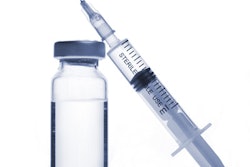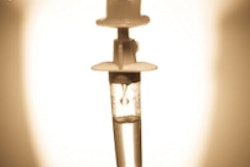
Scientists are one step closer to finding a link between local anesthetics and the failure of young permanent teeth, especially third molars. The drugs used in sedation can inhibit new pulp cell creation, potentially leading to developmental failure, according to a recent study.
 Bing Hu, DDS, MD, PhD.
Bing Hu, DDS, MD, PhD.A team of researchers from China and the U.K. found that local anesthetics lingered in the pulp cells of developing permanent teeth for hours after administration and reduced the levels of a protein critical to cell division. This could impact cell growth, the study authors noted (Cell Death Discovery, September 7, 2015).
"After investigating all the cellular events upon local anesthetic challenge, we were highly intrigued by the fact that tooth pulp cells growth could be affected by a mechanism called autophagy, a cell 'death' mechanism, rather than other 'traditional' routes such as apoptosis," said principal investigator Bing Hu, DDS, MD, PhD, in an interview with DrBicuspid.com.
Anesthetics affect cell destruction
Researchers had previously not been able to verify a connection, despite clinical observations that local anesthetics may sometimes lead to the developmental failure of growing permanent teeth. The link between the two, however, is important because of the frequent use of local anesthetics, including on adolescents whose teeth are still growing.
"We felt it was necessary to further investigate the effects of local anesthetics, particularly the ones currently used in dental clinics, because there was very little literature about it, and, clinically, we only follow the instructions from the manufacturers without knowing much more," explained Dr. Hu, an associate professor in the oral and dental health research department at Plymouth University Peninsula Schools of Medicine and Dentistry in the U.K.
“Tooth pulp cells appeared to be able to adapt themselves, but eventually the ‘protection mechanism’ collapsed if they ‘suffered’ too long under too high concentration of the drugs.”
Previous studies have shown that local anesthesia can lead to the creation of vacuoles in teeth cells and also potentially interfere with permanent tooth development, but researchers did not know how. They did know, however, that vacuoles are responsible for balancing between production and degradation of cell materials and that they also play a major role in autophagy, the destruction of cells in the body to maintain homeostasis.
Therefore, the researchers of the current study set out to evaluate how common local anesthetics affected young permanent teeth pulp cells at the molecular level. Using the mandible of a pig and in vitro human cell culture, they tested five commonly used articaine-, mepivacaine-, and lidocaine-based agents: Ubistesin and Ubistesin Forte (3M ESPE), Septanest and Scandonest (Septodont), and Xylocaine (AstraZeneca). The anesthetics tested were all injected as they would be in a clinical situation.
The researchers found that the local anesthetics remained in high concentrations even 16 hours after injection. They noted this was especially exaggerated with the nerve block method.
"We found that autophagy induced by local anesthetics appeared to be time- and dose-dependent," Dr. Hu said. "At low concentration and short time exposure, tooth pulp cells appeared to be able to adapt themselves, but eventually the 'protection mechanism' collapsed if they 'suffered' too long under too high concentration of the drugs."
| Local anesthetics' ability to penetrate developing third molars with nerve block | ||
| Concentration 2 hours postinjection in millimolars (mM) |
Concentration 16 hours postinjection in millimolars (mM) |
|
| Posterior site | 19.88 ± 14.19 mM | 16.39 ± 8.36 mM |
| Anterior site | 8.72 ± 9.43 mM | 22.23 ± 17.45 mM |
Since the local anesthetics affected the cells' ability to divide and also increased the vacuoles associated with self-destruction, the study authors concluded that it is possible then for local anesthetics to inhibit pulp cell growth for still-developing permanent teeth. As a result, the drugs may lead to those teeth's occasional failure.
The researchers also tested to see if it was possible to reduce the local anesthetics' consequences on the pulp tooth cells. They found that by using bafilomycin, a specific type of autophagy inhibitor, with each administered drug dose, they could help stop the effects of anesthetics on tooth pulp cells eight hours after administration.
More research needs to be done
While resulting in some intriguing findings, the study was not done in vivo. In addition, although the authors noted their findings have clinical implications, they are not enough to change the way dentists practice just yet.
The researchers are currently working on in vivo studies to better understand the role of local anesthetics in pulp cell destruction and what, if anything, can be done to prevent it in humans' developing permanent teeth.
"We expect to be able to further adjust the guidelines of the dose of local anesthetics and possibly formulations through our efforts," Dr. Hu said. "I am convinced such ... research is essential for improving public health."



















